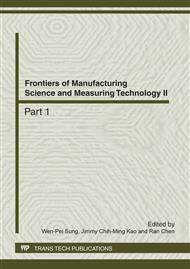p.280
p.284
p.289
p.293
p.297
p.301
p.305
p.309
p.314
Application of Orthogonal Test in Numerical Simulation of Aluminum Sheet Forming
Abstract:
Sheet forming is a high-volume fabrication method for producing lightweight materials components. An important goal in manufacturing research is to determine the optimum method for producing products with less cost. In this paper, combined with the orthogonal test method and finite element method (FEM) simulation, the analysis was carried out to analyze the key process factors such as stamping force, fillet radius, and friction coefficient. Using orthogonal test method can reduce the testing time, learn how the molding parameters influence the total equivalent plastic strain, acquire the best match forming parameters, and give guidance for the better condition
Info:
Periodical:
Pages:
297-300
Citation:
Online since:
April 2012
Authors:
Price:
Сopyright:
© 2012 Trans Tech Publications Ltd. All Rights Reserved
Share:
Citation:


